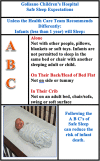An Interprofessional, Multimodal, Family-Centered Quality Improvement Project for Sleep Safety of Hospitalized Infants
- PMID: 34179431
- PMCID: PMC8205406
- DOI: 10.1177/23743735211008301
An Interprofessional, Multimodal, Family-Centered Quality Improvement Project for Sleep Safety of Hospitalized Infants
Abstract
The American Academy of Pediatrics published expanded guidelines for infant safe sleep in 2011, expanding the definition from "back to sleep" to "safe to sleep," more fully describing risk factors and guidelines. In 2016, the guidelines were revised to promote "providers modeling safe sleep behavior" to the highest level of recommendation. Previous studies have addressed the difficulty in creating clear, consistent communication between health care providers and families during an infant's inpatient stay. This institutional update describes an interprofessional and family-centered quality improvement project to improve sleep safety for hospitalized infants through a multimodal approach. Five family-centered interventions were designed: a designated safe sleep web page, a clear bedside guide to safe sleep, additional training for nursing staff in motivational interviewing, a Kamishibai card audit system, and electronic health record smart phrases. These coordinated interventions reflect advantages of an interprofessional and family-centered approach: building rapport and achieving improvements to infant sleep safety.
Keywords: health literacy; nursing; patient engagement; patient safety; pediatrics; quality improvement; trust.
© The Author(s) 2021.
Conflict of interest statement
Declaration of Conflicting Interests: The author(s) declared no potential conflicts of interest with respect to the research, authorship, and/or publication of this article.
Figures
Similar articles
-
As easy as ABC: evaluation of safe sleep initiative on safe sleep compliance in a freestanding pediatric hospital.Inj Epidemiol. 2019 May 29;6(Suppl 1):26. doi: 10.1186/s40621-019-0205-z. eCollection 2019. Inj Epidemiol. 2019. PMID: 31333992 Free PMC article.
-
Steering the Titanic: One tertiary care children's hospital's experience navigating safe sleep for hospitalized infants.J Pediatr Nurs. 2023 Nov-Dec;73:e1-e9. doi: 10.1016/j.pedn.2023.06.011. Epub 2023 Jun 15. J Pediatr Nurs. 2023. PMID: 37330278
-
The EASE Quality Improvement Project: Improving Safe Sleep Practices in Ohio Children's Hospitals.Pediatrics. 2016 Oct;138(4):e20154267. doi: 10.1542/peds.2015-4267. Epub 2016 Sep 14. Pediatrics. 2016. PMID: 27630074
-
Do nurses provide a safe sleep environment for infants in the hospital setting? An integrative review.Adv Neonatal Care. 2015 Feb;15(1):8-22. doi: 10.1097/ANC.0000000000000145. Adv Neonatal Care. 2015. PMID: 25626979 Review.
-
Clinical Practice Guideline: Tonsillectomy in Children (Update)-Executive Summary.Otolaryngol Head Neck Surg. 2019 Feb;160(2):187-205. doi: 10.1177/0194599818807917. Otolaryngol Head Neck Surg. 2019. PMID: 30921525 Review.
References
-
- McMullen SL, Fioravanti ID, Brown K, Carey MG. Safe sleep for hospitalized infants. MCN Am J Matern Child Nurs. 2016;14:43–50. - PubMed
-
- American Academy of Pediatrics Task Force on SIDS. SIDS and other sleep-related infant deaths: expansion of recommendations for a safe infant sleeping environment. Pediatrics. 2011;128:e1451. - PubMed
-
- National Institute of Child Health and Human Development. What Does a Safe Sleep Environment Look Like? 2019. Retrieved July 13, 2020, from: https://www.nichd.nih.gov/sites/default/files/2019-02/Safe_Sleep_Environ...
-
- Task Force on Sudden Infant Death Syndrome. SIDS and other sleep-related infant deaths: updated 2016 recommendations for a safe infant sleeping environment. Pediatrics. 2016;138:e20162938. - PubMed
-
- Mcmullen SL, Wu Y, Austin-Ketch T, Carey MG. Transitioning the premature infant from nonsupine to supine position prior to hospital discharge. Neonatal Netw. 2014;33:194–8. - PubMed
Publication types
LinkOut - more resources
Full Text Sources





